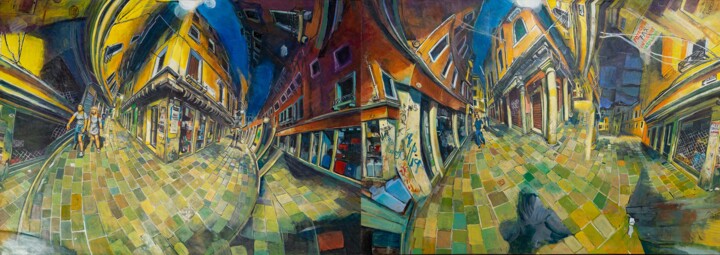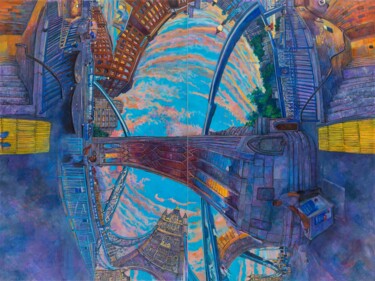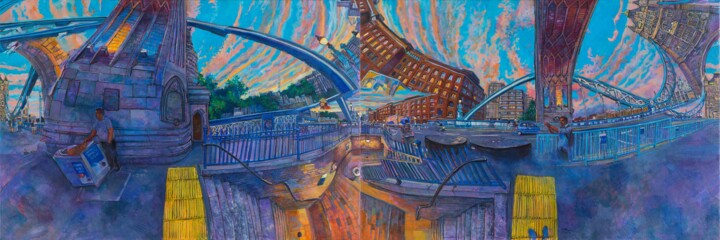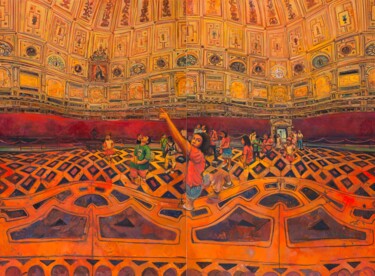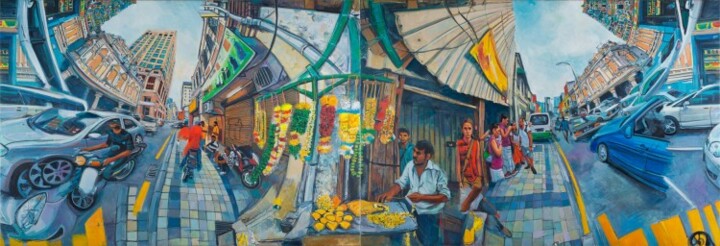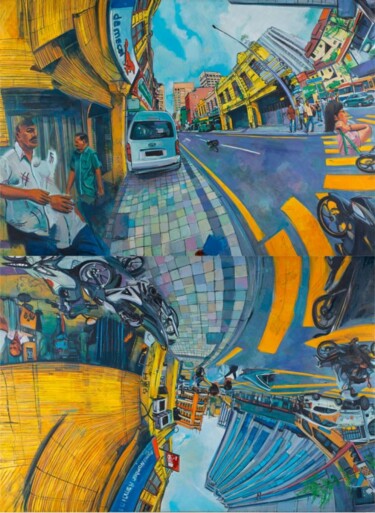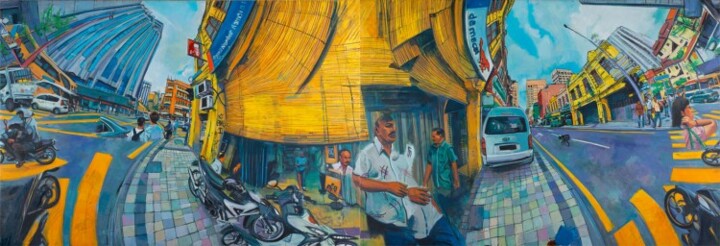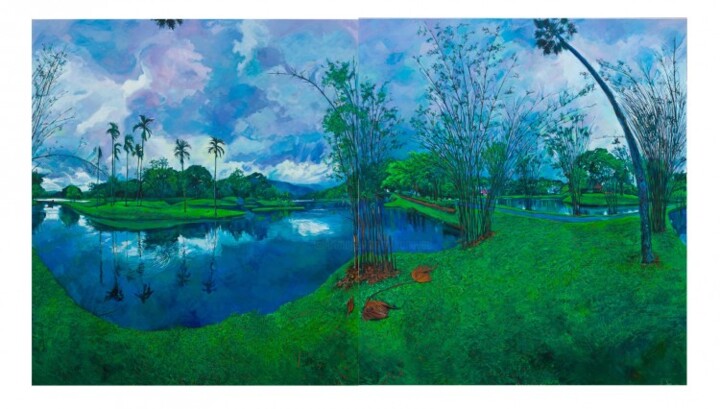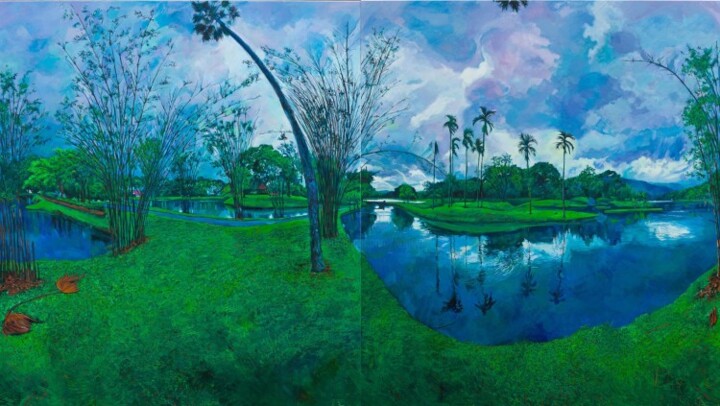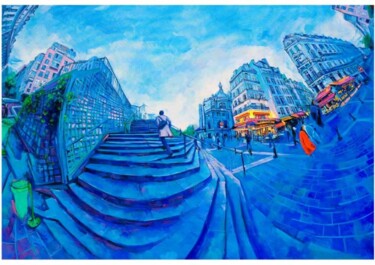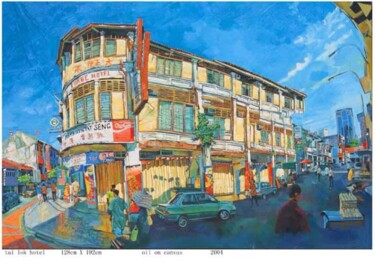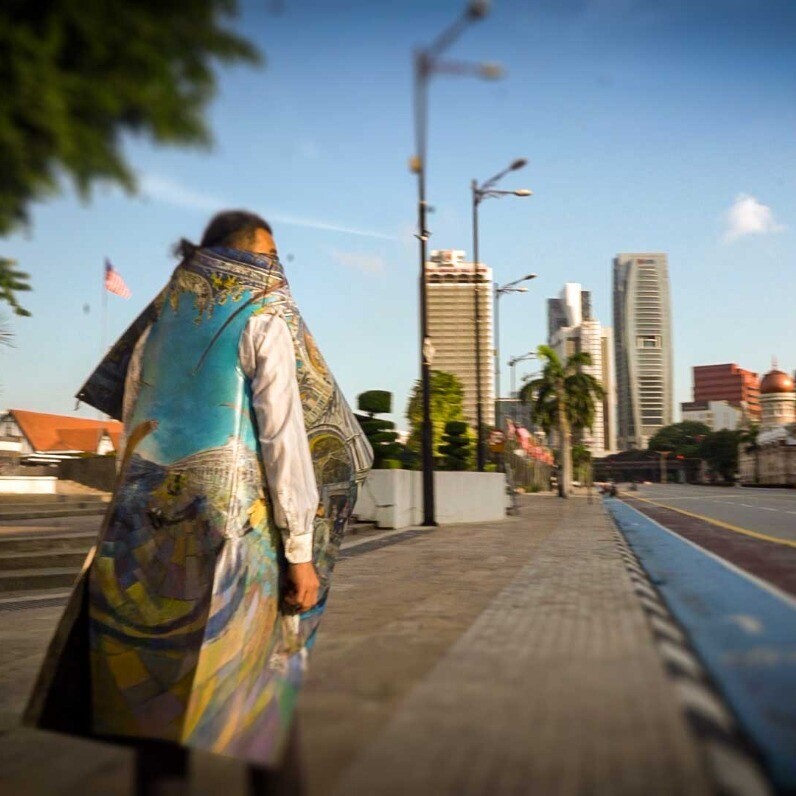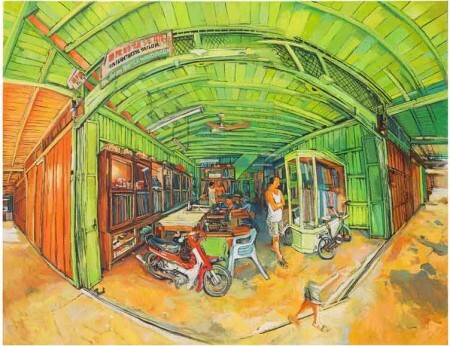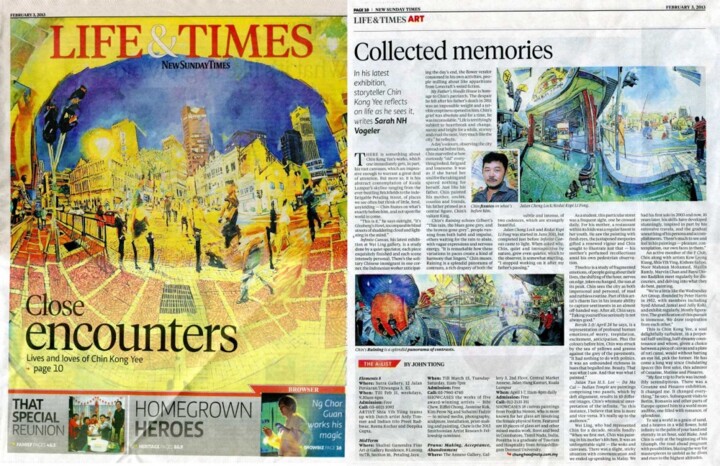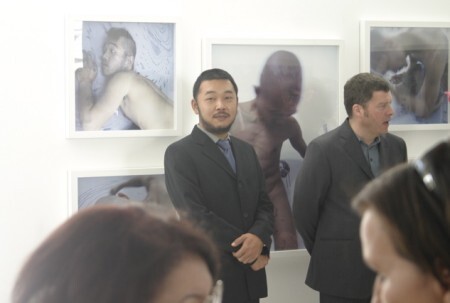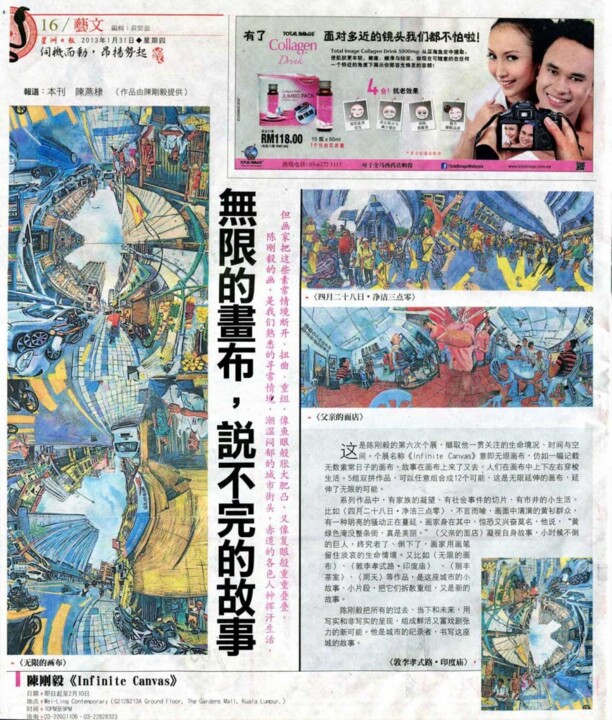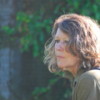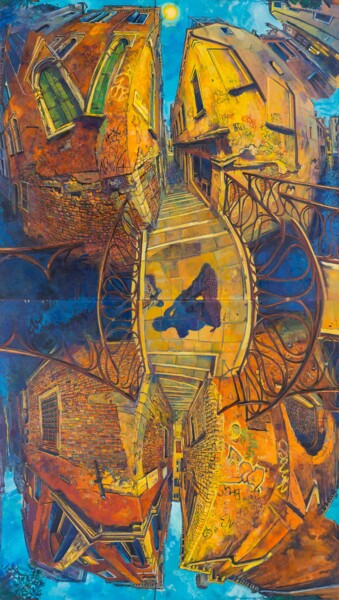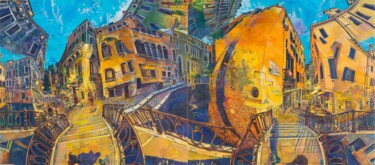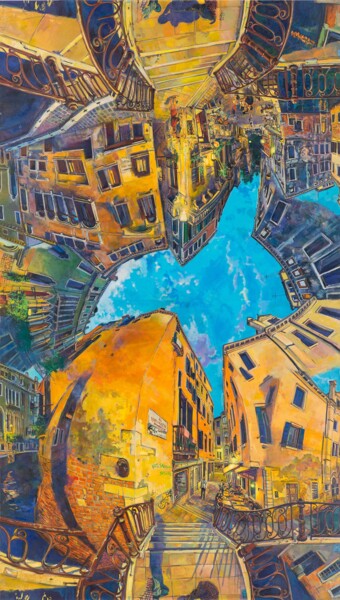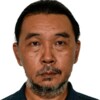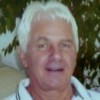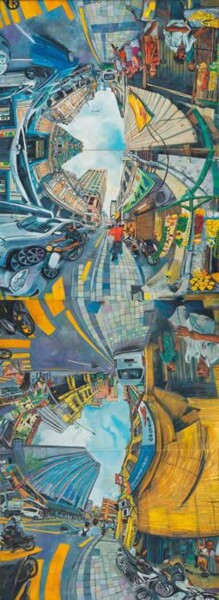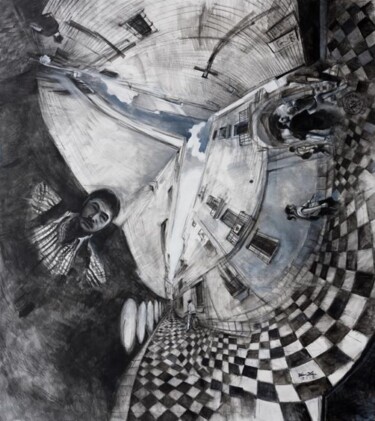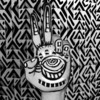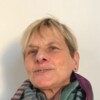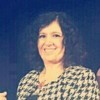Alle kunstwerken van Chin Kong Yee
#tomorrow • 11 kunstwerken
Bekijk alles
Chin Kong Yee’s latest exhibition #tomorrow, which sees him pushing his boundaries as an artist, by [...]
Chin Kong Yee’s latest exhibition #tomorrow, which sees him pushing his boundaries as an artist, by experimenting with wearable paintings, video work, and performance. Moved by his experience of “Acqua Alta” in Venice, a natural disaster which saw sea levels rising, causing the city to flood, Kong Yee felt the need to retell the story through his paintings, hoping to amplify an awareness of the pressing need to preserve our environment and society, to the detriment of our future if we leave it unattended.
In November 2019, Venice suffered its worst high tide in 50 years. Over 80% of the city was submerged by water, and residents had to flood-proof and barricade their homes and businesses. Many houses, hotels, and restaurants were destroyed. This phenomenon coincided with the Venice Art Biennale 2019, and as a result, some National Pavilions had to close their doors to visitors. Chin Kong Yee found himself in the middle of this situation, being in Venice to carry out his performative work, which saw him walking into the various exhibitions in his wearable painting.
As a painter and a traveler, Kong Yee puts himself in the position of an observer when going to a place, rather than merely visiting as a tourist. Instead of avoiding the flood, he put on a pair of waterproof boots, and continued immersing himself in the city, one that he has always been fascinated and moved by. He recalls, “After the deafening alarm noise to warn us of the water rise, there’s always a peaceful silence”. It was to his surprise that upon returning to Malaysia, he experienced a flash flood that affected his own house. With these incidents taking place one after another, it became clear to him that if we do not come together and channel our efforts towards addressing this pressing situation, our lands will gradually sink and disappear.
Since 2019, he has also been experimenting with the idea of ‘wearable art’, in which he would cut and stitch pieces of the leather based on a pattern before painting on its surface, enabling his paintings to be worn. His signature style of adopting a fish-eye lens perspective and combining the past, present, and future through his “Actually Accorded Painting” (AAP) technique, is yet again present in these recent paintings. The concept of presenting the past, present, and future is also reflected through the different periods of time that are presented through this exhibition, in relation to the pandemic. To a true traveller like Kong Yee, the experience of staying at home for the past 20 months was life changing. Isolated throughout the lockdown, he took himself back to the feeling of being surrounded by people, through 360-degree paintings of market scenes such as Pasar Seni (20192021) and Pasar Ubud - Bali (2014), as well as the night scenery of Venice. Consisting of two interchangeable panels, Summer Night in Venice (2021) allows multiple display arrangements; a technique that he started developing in 2010.
In November 2019, Venice suffered its worst high tide in 50 years. Over 80% of the city was submerged by water, and residents had to flood-proof and barricade their homes and businesses. Many houses, hotels, and restaurants were destroyed. This phenomenon coincided with the Venice Art Biennale 2019, and as a result, some National Pavilions had to close their doors to visitors. Chin Kong Yee found himself in the middle of this situation, being in Venice to carry out his performative work, which saw him walking into the various exhibitions in his wearable painting.
As a painter and a traveler, Kong Yee puts himself in the position of an observer when going to a place, rather than merely visiting as a tourist. Instead of avoiding the flood, he put on a pair of waterproof boots, and continued immersing himself in the city, one that he has always been fascinated and moved by. He recalls, “After the deafening alarm noise to warn us of the water rise, there’s always a peaceful silence”. It was to his surprise that upon returning to Malaysia, he experienced a flash flood that affected his own house. With these incidents taking place one after another, it became clear to him that if we do not come together and channel our efforts towards addressing this pressing situation, our lands will gradually sink and disappear.
Since 2019, he has also been experimenting with the idea of ‘wearable art’, in which he would cut and stitch pieces of the leather based on a pattern before painting on its surface, enabling his paintings to be worn. His signature style of adopting a fish-eye lens perspective and combining the past, present, and future through his “Actually Accorded Painting” (AAP) technique, is yet again present in these recent paintings. The concept of presenting the past, present, and future is also reflected through the different periods of time that are presented through this exhibition, in relation to the pandemic. To a true traveller like Kong Yee, the experience of staying at home for the past 20 months was life changing. Isolated throughout the lockdown, he took himself back to the feeling of being surrounded by people, through 360-degree paintings of market scenes such as Pasar Seni (20192021) and Pasar Ubud - Bali (2014), as well as the night scenery of Venice. Consisting of two interchangeable panels, Summer Night in Venice (2021) allows multiple display arrangements; a technique that he started developing in 2010.
Dancing with Shadows • 26 kunstwerken
Bekijk alles
Chin Kong Yee’s latest exhibition ‘Dancing with Shadows’ comprises of only five major masterpieces. [...]
Chin Kong Yee’s latest exhibition ‘Dancing with Shadows’ comprises of only five major masterpieces.
Known for his unique fish eye painting composition; Chin Kong Yee morphs the past, present and future into one infinite image. The artist depicts the idea of time as a surreal ideology as though we are constantly in a state of change yet staticity, an eternal loop. Prompting viewers to question the very meaning of time.
As an artist, Chin Kong Yee has evolved and transcended his art from a simple fish eye lens composition (seen in his ‘(eye)-llusions’ series) into pivoted on axis, whereby the work can be rotated 360 degree (seen in his ‘Infinite Canvas – Kuala Lumpur’ and ‘The Flower’ series) and finally into interchangeable art pieces. He has established his own personal painting style ‘Actuality Accorded Painting’ (AAP) that captures the image in the present, as though the viewer were to experience it the moment themselves, rather than observing a static image from the past. The progression of his work runs parallel to his progression as an artist in delivering this visual message of an abiding world.
Working with a style filled with intense dynamism, distortion and unique composition, viewers are inevitably pulled into his works as though they were to enter a different, surreal and timeless reality. Evoking this sense of immortality and invisibility. In ‘Dancing with Shadows’ Chin Kong Yee explores this very notion through his depiction of different European cities such as London and Venice.
Upon his third revisit to Venice, a city that at first left him lost and alone with the foreign scape and shadows of the night. He found himself sitting in Piazza San Marco, where he was taken back 12 years ago. The city was left frozen; the music, the moon and the scene all remained unchanged from a decade earlier. With only his own age and presence acting as an indicator to distinguish the change of time, he found him self in this surreal, timeless and infinite realm.
Inspired by this time-conflicting and surreal experience in Venice, Chin Kong Yee developed his visual narration of time through a series of oil paintings with a strong emphasis on shadows. These paintings are considered interchangeable as they can be organised in multiple different combinations in order to reflect the ever changing and evolving yet static entity of time.
Dancing with Shadows will be showing from 9th August to 2nd September 2018 at Wei-Ling Contemporary.
Known for his unique fish eye painting composition; Chin Kong Yee morphs the past, present and future into one infinite image. The artist depicts the idea of time as a surreal ideology as though we are constantly in a state of change yet staticity, an eternal loop. Prompting viewers to question the very meaning of time.
As an artist, Chin Kong Yee has evolved and transcended his art from a simple fish eye lens composition (seen in his ‘(eye)-llusions’ series) into pivoted on axis, whereby the work can be rotated 360 degree (seen in his ‘Infinite Canvas – Kuala Lumpur’ and ‘The Flower’ series) and finally into interchangeable art pieces. He has established his own personal painting style ‘Actuality Accorded Painting’ (AAP) that captures the image in the present, as though the viewer were to experience it the moment themselves, rather than observing a static image from the past. The progression of his work runs parallel to his progression as an artist in delivering this visual message of an abiding world.
Working with a style filled with intense dynamism, distortion and unique composition, viewers are inevitably pulled into his works as though they were to enter a different, surreal and timeless reality. Evoking this sense of immortality and invisibility. In ‘Dancing with Shadows’ Chin Kong Yee explores this very notion through his depiction of different European cities such as London and Venice.
Upon his third revisit to Venice, a city that at first left him lost and alone with the foreign scape and shadows of the night. He found himself sitting in Piazza San Marco, where he was taken back 12 years ago. The city was left frozen; the music, the moon and the scene all remained unchanged from a decade earlier. With only his own age and presence acting as an indicator to distinguish the change of time, he found him self in this surreal, timeless and infinite realm.
Inspired by this time-conflicting and surreal experience in Venice, Chin Kong Yee developed his visual narration of time through a series of oil paintings with a strong emphasis on shadows. These paintings are considered interchangeable as they can be organised in multiple different combinations in order to reflect the ever changing and evolving yet static entity of time.
Dancing with Shadows will be showing from 9th August to 2nd September 2018 at Wei-Ling Contemporary.
The Flower • 12 kunstwerken
Bekijk alles
A Closer Look at ‘The Flower’ There are a couple of facets to the enjoyment of Chin Kong Yee’s works. [...]
A Closer Look at ‘The Flower’
There are a couple of facets to the enjoyment of Chin Kong Yee’s works. First, and the most evident, is the visual pleasure that his paintings bring. Saccharine yellows flirt with lush cobalt blues on the canvas, and swirling landscapes send the eyes on a kaleidoscopic viewing journey that has become the artist’s signature offering. Less obvious, though, are the subtle nuances that make up each work. There are the personal tales and precise moments in time when the scene was captured, and philosophical musings that simmer beneath the surfaces. So, despite their seemingly benign facades, Kong Yee’s works are complex creatures. And the artist, a critical filter of life.
The artist’s latest body of work comprises ten paintings, and understanding them means to trace aspects of Kong Yee’s career. For one, we need to note how his painterly style hinges greatly on European painting legacies, and how his use of photographic tools throws his practice into more recent times. Duomo Florence is a vivid expression of this marriage. In the work, the great Florentine cathedral takes centre stage and is flanked by two gravity-defying buildings that threaten to topple upon it. Such fish-eye twists to perspective have come to define Kong Yee’s works. And, the irony in this particular composition lies in the fact that Florence is the reputed birthplace of linear perspective; Masaccio’s early Renaissance painting, Holy Trinity, can be found at the city’s Santa Maria Novella church, and it takes podium place for its use of this spatial rule – the very one that Kong Yee flouts in his art.
But it’s not just Occidental traditions that we can reference in Kong Yee’s latest works. A relatively new addition to the artist’s opus is the use of traditional xuan paper and Chinese calligraphy, as seen in Tia Garden & Chinese Calligraphy. Based on his own experiences in Berlin’s sprawling inner-city park, Tiergarten, the work features an autumnal-coloured patch with thousands of Chinese characters written in ink. This specific element pays homage to the complexities of Chinese script and how repetitions in the thousands are necessary to achieve levels of mastery. Musing on this, Kong Yee pokes fun at life’s challenges and confesses to his own unique brand of coping. “Life is 3D, written (forms) are 2D, but once read, it becomes 4D. So, I make it unreadable,” he says, referring to the work’s bed of Chinese characters and his own struggles learning German during his one-month stint in the capital city.
It’s this errant humour that characterizes the artist’s approach. And, during the course of our discussion on The Flower, the artist makes a joke about the socially-demanded linearity of thoughts and how manmade environments are all crafted along straight lines. Funny, he observes, pointing out rightly that the earth is round. This could explain why Kong Yee’s horizontal panoramas of yore now reappear within more compact formats and circular guises, and how increasingly, the artist has shifted from atmospheric portrayals to detailed inspections. Indeed, there are introspective, zen-like qualities to works like the verdant Forest, or the eponymous painting The Flower. “Everything only happens in the present,” says Kong Yee, drawing not-so-subtle hints to Buddhist teachings, and how the entire exhibition symbolizes the fact that the blooming of a flower is contained within a single moment and cannot be recaptured or repeated in its exactness. Could we not say the same of the ephemeral moments of life that Kong Yee captures in his works?
The two Dresden in Blue paintings illustrate this point, with both works showcasing rich blue light that could only have resulted from specific temperatures and other atmospheric conditions. Or, in U Turn, where a small group of people seem to march their bicycles out of one side of the painting and where a moving bicycle seems to spring forth from the opposite side. This decisive, unrepeatable moment – the photographic punctum or punctuation, as described by Henri Cartier-Bresson – is exactly what Kong Yee captures in his works, and like a flower that blooms, each scene is a compression of thousands of moments, stories, and elements rolled into one. Kong Yee’s compositions are anything but linear.
There’s some logic then, in Kong Yee’s adoption of the Golden Ratio. A mathematical principle that constitutes two rectangular shapes and a golden spiral, Kong Yee uses its principles to lay out the formal properties of all the works in this series. The Flower displays the golden spiral clearly, and so does Orange Flower, a portrayal of a vaulted church ceiling that curls upon itself and which seems to be doused in a glowing, golden-orange bath of light. These two accompanying works are regal and beatific, and the level of accuracy in the architectural detail is only accentuated by the artist’s investment in every other aspect of the subject matter; Kong Yee wasn’t just concerned with the physical spaces of the churches in these two works, but also researched other ecclesiastical aspects, such as the type of music they play in churches and how it affects people’s moods.
Kong Yee’s works lack aural properties, of course, but the artist certainly aims to encapsulate as many sensorial experiences into his works as he can. Indeed, Kong Yee presents a very keen and observant view of the world. He always has, and as an artist, plays the role of a ‘fly on the wall’ and a secret eye on the streets. With years of experience charting life unravelling before him, he has developed highly-tuned sensitivities to the temperaments of the weather, how these may have an effect on people’s moods, and even considers real-world developments like the fluctuating oil prices, headlines that inevitably seep beneath the conscious human skin. In many ways, he ruminates all of this to try to bring us back to the very moment when the flower first ‘bloomed’ before his eyes.
Though not exhibited with the rest of The Flower works in the exhibition, Kong Yee’s painting of Busan is his favourite in the series. It’s where the sky is at its most evocative, spreading steel-grey swathes across the sky, and where Kong Yee channels his artistic language through the waves swirling in curly lines across the canvas and the plays of ink that pay homage to classic Chinese ink paintings. The work seems to hint that our possibilities are endless, and maybe they are. The elasticity of time is mentioned several times by the artist in descriptions of his work, and he hints that the warmer shades of his palette play a role in his past, while the cooler blues are a reference to the future. Perhaps Kong Yee’s own words sum it up best. “I have been a practising artist for 16 years now. From Undulating Spaces to this latest solo exhibition, I have been on a continuous exploration of space and time, and I have finally figured out that time is not linear. The past, present, and future are all happening simultaneously. The past continues to change as our state of mind changes, in turn affecting how our future plays out.”
There’s hope and promise in those words, and a palpable belief that nothing is permanent. After all, flowers continue to bloom and though each one only blooms once, there is nothing more beautiful and wondrous than pausing to enjoy a single, irretrievable moment. Thank you for reminding us to do just that, Kong Yee.
Rachel Jenagaratnam
March, 2016
There are a couple of facets to the enjoyment of Chin Kong Yee’s works. First, and the most evident, is the visual pleasure that his paintings bring. Saccharine yellows flirt with lush cobalt blues on the canvas, and swirling landscapes send the eyes on a kaleidoscopic viewing journey that has become the artist’s signature offering. Less obvious, though, are the subtle nuances that make up each work. There are the personal tales and precise moments in time when the scene was captured, and philosophical musings that simmer beneath the surfaces. So, despite their seemingly benign facades, Kong Yee’s works are complex creatures. And the artist, a critical filter of life.
The artist’s latest body of work comprises ten paintings, and understanding them means to trace aspects of Kong Yee’s career. For one, we need to note how his painterly style hinges greatly on European painting legacies, and how his use of photographic tools throws his practice into more recent times. Duomo Florence is a vivid expression of this marriage. In the work, the great Florentine cathedral takes centre stage and is flanked by two gravity-defying buildings that threaten to topple upon it. Such fish-eye twists to perspective have come to define Kong Yee’s works. And, the irony in this particular composition lies in the fact that Florence is the reputed birthplace of linear perspective; Masaccio’s early Renaissance painting, Holy Trinity, can be found at the city’s Santa Maria Novella church, and it takes podium place for its use of this spatial rule – the very one that Kong Yee flouts in his art.
But it’s not just Occidental traditions that we can reference in Kong Yee’s latest works. A relatively new addition to the artist’s opus is the use of traditional xuan paper and Chinese calligraphy, as seen in Tia Garden & Chinese Calligraphy. Based on his own experiences in Berlin’s sprawling inner-city park, Tiergarten, the work features an autumnal-coloured patch with thousands of Chinese characters written in ink. This specific element pays homage to the complexities of Chinese script and how repetitions in the thousands are necessary to achieve levels of mastery. Musing on this, Kong Yee pokes fun at life’s challenges and confesses to his own unique brand of coping. “Life is 3D, written (forms) are 2D, but once read, it becomes 4D. So, I make it unreadable,” he says, referring to the work’s bed of Chinese characters and his own struggles learning German during his one-month stint in the capital city.
It’s this errant humour that characterizes the artist’s approach. And, during the course of our discussion on The Flower, the artist makes a joke about the socially-demanded linearity of thoughts and how manmade environments are all crafted along straight lines. Funny, he observes, pointing out rightly that the earth is round. This could explain why Kong Yee’s horizontal panoramas of yore now reappear within more compact formats and circular guises, and how increasingly, the artist has shifted from atmospheric portrayals to detailed inspections. Indeed, there are introspective, zen-like qualities to works like the verdant Forest, or the eponymous painting The Flower. “Everything only happens in the present,” says Kong Yee, drawing not-so-subtle hints to Buddhist teachings, and how the entire exhibition symbolizes the fact that the blooming of a flower is contained within a single moment and cannot be recaptured or repeated in its exactness. Could we not say the same of the ephemeral moments of life that Kong Yee captures in his works?
The two Dresden in Blue paintings illustrate this point, with both works showcasing rich blue light that could only have resulted from specific temperatures and other atmospheric conditions. Or, in U Turn, where a small group of people seem to march their bicycles out of one side of the painting and where a moving bicycle seems to spring forth from the opposite side. This decisive, unrepeatable moment – the photographic punctum or punctuation, as described by Henri Cartier-Bresson – is exactly what Kong Yee captures in his works, and like a flower that blooms, each scene is a compression of thousands of moments, stories, and elements rolled into one. Kong Yee’s compositions are anything but linear.
There’s some logic then, in Kong Yee’s adoption of the Golden Ratio. A mathematical principle that constitutes two rectangular shapes and a golden spiral, Kong Yee uses its principles to lay out the formal properties of all the works in this series. The Flower displays the golden spiral clearly, and so does Orange Flower, a portrayal of a vaulted church ceiling that curls upon itself and which seems to be doused in a glowing, golden-orange bath of light. These two accompanying works are regal and beatific, and the level of accuracy in the architectural detail is only accentuated by the artist’s investment in every other aspect of the subject matter; Kong Yee wasn’t just concerned with the physical spaces of the churches in these two works, but also researched other ecclesiastical aspects, such as the type of music they play in churches and how it affects people’s moods.
Kong Yee’s works lack aural properties, of course, but the artist certainly aims to encapsulate as many sensorial experiences into his works as he can. Indeed, Kong Yee presents a very keen and observant view of the world. He always has, and as an artist, plays the role of a ‘fly on the wall’ and a secret eye on the streets. With years of experience charting life unravelling before him, he has developed highly-tuned sensitivities to the temperaments of the weather, how these may have an effect on people’s moods, and even considers real-world developments like the fluctuating oil prices, headlines that inevitably seep beneath the conscious human skin. In many ways, he ruminates all of this to try to bring us back to the very moment when the flower first ‘bloomed’ before his eyes.
Though not exhibited with the rest of The Flower works in the exhibition, Kong Yee’s painting of Busan is his favourite in the series. It’s where the sky is at its most evocative, spreading steel-grey swathes across the sky, and where Kong Yee channels his artistic language through the waves swirling in curly lines across the canvas and the plays of ink that pay homage to classic Chinese ink paintings. The work seems to hint that our possibilities are endless, and maybe they are. The elasticity of time is mentioned several times by the artist in descriptions of his work, and he hints that the warmer shades of his palette play a role in his past, while the cooler blues are a reference to the future. Perhaps Kong Yee’s own words sum it up best. “I have been a practising artist for 16 years now. From Undulating Spaces to this latest solo exhibition, I have been on a continuous exploration of space and time, and I have finally figured out that time is not linear. The past, present, and future are all happening simultaneously. The past continues to change as our state of mind changes, in turn affecting how our future plays out.”
There’s hope and promise in those words, and a palpable belief that nothing is permanent. After all, flowers continue to bloom and though each one only blooms once, there is nothing more beautiful and wondrous than pausing to enjoy a single, irretrievable moment. Thank you for reminding us to do just that, Kong Yee.
Rachel Jenagaratnam
March, 2016
Infinite Canvas • 16 kunstwerken
Bekijk alles
Infinite Canvas illustrates various city landscapes which wholly depicts the essence of Kuala Lumpur [...]
Infinite Canvas illustrates various city landscapes which wholly depicts the essence of Kuala Lumpur life. The body of work within this exhibition consist of 5 pieces of 2 panels each, which can be placed interchangeably to allow for 12 possible arrangements.
Having held his first solo exhibition entitled ‘Undulating Spaces’ with Wei-Ling Gallery (then known as the Townhouse Gallery) in 2003, he has progressively moved forward through the years with solo shows such as ‘Cerulean Skies’, ‘Reality in Wonderland’ and ‘New Landscapes’. ‘Reality in Wonderland’ marked Kong Yee’s tenth year as a practicing artist and with this exhibition came a 65 page publication showcasing the various sojourns beyond Malaysian grounds, which he had embarked upon through time.
Chin Kong Yee’s paintings display his continuous search to capture his own experience of a time and place. Highly known for his wonderful fish-eye lens work, this artist’s works evoke a somewhat surreal feel about them. By combining the present, past and future through a depiction of two perspectives (realistic and unrealistic) his paintings have an exciting, dramatic edge about them that draws the viewer into his space. Chin Kong Yee seeks his audience to feel and see what he has experienced in the creation of his artwork. He has labeled his style as Actuality Accorded Painting (AAP), whereby, in painting and portraying an object, it has to have existed, and have undergone the process of being real, in order for it to be translated onto the canvas as art. AAP is basically the act of “seeing” where the past, the present and the future is enveloped into one when one looks at an object. Once eye contact has been made through AAP, the images become the past. To this artist, nothing is ever stagnant. Images are changing and evolving as you look at them. Space can never be measured or fixed and it is only present in the mobility of time.
Having held his first solo exhibition entitled ‘Undulating Spaces’ with Wei-Ling Gallery (then known as the Townhouse Gallery) in 2003, he has progressively moved forward through the years with solo shows such as ‘Cerulean Skies’, ‘Reality in Wonderland’ and ‘New Landscapes’. ‘Reality in Wonderland’ marked Kong Yee’s tenth year as a practicing artist and with this exhibition came a 65 page publication showcasing the various sojourns beyond Malaysian grounds, which he had embarked upon through time.
Chin Kong Yee’s paintings display his continuous search to capture his own experience of a time and place. Highly known for his wonderful fish-eye lens work, this artist’s works evoke a somewhat surreal feel about them. By combining the present, past and future through a depiction of two perspectives (realistic and unrealistic) his paintings have an exciting, dramatic edge about them that draws the viewer into his space. Chin Kong Yee seeks his audience to feel and see what he has experienced in the creation of his artwork. He has labeled his style as Actuality Accorded Painting (AAP), whereby, in painting and portraying an object, it has to have existed, and have undergone the process of being real, in order for it to be translated onto the canvas as art. AAP is basically the act of “seeing” where the past, the present and the future is enveloped into one when one looks at an object. Once eye contact has been made through AAP, the images become the past. To this artist, nothing is ever stagnant. Images are changing and evolving as you look at them. Space can never be measured or fixed and it is only present in the mobility of time.
New Landscapes • 11 kunstwerken
Bekijk alles
New Landscapes features four new large paintings by Chin Kong Yee. Landscapes, are a theme that Kong [...]
New Landscapes features four new large paintings by Chin Kong Yee.
Landscapes, are a theme that Kong Yee has always been fascinated with.
In this suite of paintings he has managed to push the boundaries of his art-making by looking at how one painting(on two canvases) can be reconfigured to create a whole new scene ,and thus change the thrust of what is initially seen by the viewer.This versatility and innovation stems from his desire to create works which are multifaceted and displays his ability to create a new dimension in his wonderful fish-eye lens works which he has become well-known for. Following on from the captivating scenes of Europe that were seen at his last solo exhibition 'Reality in Wonderland', these four new paintings feature a combination of places ranging from the coast of Portugal to the haunting raintrees around Lake Taiping, Malaysia.
"New Landscapes" shows us Chin Kong Yee's strength as an artist and his desire to continue making paintings which excite the senses.
Landscapes, are a theme that Kong Yee has always been fascinated with.
In this suite of paintings he has managed to push the boundaries of his art-making by looking at how one painting(on two canvases) can be reconfigured to create a whole new scene ,and thus change the thrust of what is initially seen by the viewer.This versatility and innovation stems from his desire to create works which are multifaceted and displays his ability to create a new dimension in his wonderful fish-eye lens works which he has become well-known for. Following on from the captivating scenes of Europe that were seen at his last solo exhibition 'Reality in Wonderland', these four new paintings feature a combination of places ranging from the coast of Portugal to the haunting raintrees around Lake Taiping, Malaysia.
"New Landscapes" shows us Chin Kong Yee's strength as an artist and his desire to continue making paintings which excite the senses.
Reality in Wonderland • 14 kunstwerken
Bekijk alles
CHIN KONG YEE: THE MASTER OF BEGUILING DISTORTIONS by Francis DassIt is good to see Chin Kong Yee's [...]
CHIN KONG YEE: THE MASTER OF BEGUILING DISTORTIONS
by Francis DassIt is good to see Chin Kong Yee's star rising again on everyone's radar with his latest and very compelling exhibition, titled "Reality in Wonderland", at Wei-Ling Gallery. Eleven wondrous new oil paintings are being showcased this time.
Looking at his new works, I do indeed get a sense of reality in wonderland, which has to be the most apt title for this exhibition. The structures in his paintings are real -- but there's Kong Yee's signature warping of the visuals and clustering of them to breathtaking effect. Yet, somehow, for all the exaggeration and heightening that the forms are put through, we all know that these places do exist. You can't help when you look at Kong Yee's oil paintings but smile in your mind and think to yourself, "Wow! If only the rest of us could see things that way!"
These new paintings are the fruits of Kong Yee's sojourns to Europe and Bali and were completed between 2008 and now. Places like Paris and Nice in France; Venice and Florence (Italy); Prague (Czech Republic); Portugal and Bali are rendered on canvas with twisted panache by Kong Yee. All the works are visually kneaded and stretched in Kong Yee's trademark style and what viewers get to see are indeed truly original and majestic portrayal of dignified buildings and places.
Like with all artists, colours, of course, play a major role in the success of Kong Yee's artistic endeavours. Colours do more than their assigned role of conveying emotions.
On the surface, the reds, blues, greens and a smattering of other colours indicate whether it is day or night or natural or artificial lights at play.
"Cathedral in Red" for example, has a nighttime setting but there is an interesting story behind the choice of colour. There was a fashion show being held at the cathedral when Kong Yee was visiting and the whole place was bathed in red light for effect by the fashion show organisers.
With other paintings, the tinges of green and blues on building and on the landscape in pieces like "Portugal", "Duomo Florence" and "Venice at Night" hint at dusk or nighttime. Yellow, naturally, depicts sunlight. These are simple and straightforward readings.
Now, all that was on-the-surface talk. Beneath the surface, however ( -- and despite Kong Yee's calm demeanour!), the artist intensely wrestles with the colours in each painting as he tries to subdue them and make them serve his purpose and vision.
"Red is actually a violent colour, although the Chinese see it as a lucky colour. I find red an exciting colour but a difficult one to express. You have to control it or it is going to go over-the-top."
So, how do you deal with it?
"The artist has to find a way and this could take a lot out of him until he gets it to do what he want it to do," he explains, rather philosophically.
Kong Yee, needless to say, always gets his colours to do his bidding.
An outstanding part of the exhibition is a trifecta of paintings depicting people. "Walking"; "Bali" and "Nice 2" show Kong Yee's mastery of the human form. In his early days as an artist, he delved extensively into portrait painting and he has obviously mastered the dynamics of the human form. These three paintings are delightful because they draw our attention to the movement of people. There are no warping or distortions in these three particular pieces.
"These three pieces are like my "Life Museum" pieces. When a group of people are doing the same thing (in this case, walking), I find it very attractive. These are studies in movements," he reveals.
At this point, it bears saying that it has been one of my greatest privileges indeed to have met Chin Kong Yee and cultivated a friendship with this talented artist for about half a decade now. Born-bred-and-raised in the bustling city of Kuala Lumpur, Kong Yee's casual and easygoing manner run counter to the almost-staggering visions of reality that he presents both in his oil paintings and photography.
(Yes, he is also a very talented photographer. Earlier this year, I had the great privilege of seeing his digital photography works and I must say that they are beautiful glossy counterparts to the paintings that Kong Yee is most famous for. If you are interested in photography, his photography are must-see works.)
His mastery of paintings and photography are so complete that I dare say that he is a multi-medium genius indeed. Both in photographic print and on the canvas, his works are always visually vibrant.
In keeping with artistic traditions, on canvas, Kong Yee's works have indeed been informed by famous artists, like his favourite French painter, Paul Cezanne.
Even artists who made an impression on him in his student days, have had an effect on the works he produces today, however mildly it might be. Take Dutch artist M.C. Escher, for example.
"I saw works of M.C. Escher when I was a student and I was very inspired. Escher is more like a scientist than an artist. I like his logical take on things," says Kong Yee.
When prodded as to why he likes Cezanne, Kong Yee says, "Cezanne has always been very inspiring and has always been my favourite artist. I decided to become a professional artist because of Paul Cezanne. During my student days, he was always talked about as the father of modern art. I especially love the landscape works he has done. You can feel the landscape! Until today, I have not seen another artist who can paint landscape the way Cezanne did."
Of his own style, actually Kong Yee himself says it best: "I was thinking about the kind of art works that I have done and I asked myself why my paintings have a lot of things surrounding me. That's because Klang Valley really is a valley and we are always surrounded by things. We don't have a distinct horizontal line."
Indeed, our lives inform the kind of works of art that we produce!
With a capacity for self-reflection like that, is it any wonder at all that Chin Kong Yee's star is on the ascendancy?
by Francis DassIt is good to see Chin Kong Yee's star rising again on everyone's radar with his latest and very compelling exhibition, titled "Reality in Wonderland", at Wei-Ling Gallery. Eleven wondrous new oil paintings are being showcased this time.
Looking at his new works, I do indeed get a sense of reality in wonderland, which has to be the most apt title for this exhibition. The structures in his paintings are real -- but there's Kong Yee's signature warping of the visuals and clustering of them to breathtaking effect. Yet, somehow, for all the exaggeration and heightening that the forms are put through, we all know that these places do exist. You can't help when you look at Kong Yee's oil paintings but smile in your mind and think to yourself, "Wow! If only the rest of us could see things that way!"
These new paintings are the fruits of Kong Yee's sojourns to Europe and Bali and were completed between 2008 and now. Places like Paris and Nice in France; Venice and Florence (Italy); Prague (Czech Republic); Portugal and Bali are rendered on canvas with twisted panache by Kong Yee. All the works are visually kneaded and stretched in Kong Yee's trademark style and what viewers get to see are indeed truly original and majestic portrayal of dignified buildings and places.
Like with all artists, colours, of course, play a major role in the success of Kong Yee's artistic endeavours. Colours do more than their assigned role of conveying emotions.
On the surface, the reds, blues, greens and a smattering of other colours indicate whether it is day or night or natural or artificial lights at play.
"Cathedral in Red" for example, has a nighttime setting but there is an interesting story behind the choice of colour. There was a fashion show being held at the cathedral when Kong Yee was visiting and the whole place was bathed in red light for effect by the fashion show organisers.
With other paintings, the tinges of green and blues on building and on the landscape in pieces like "Portugal", "Duomo Florence" and "Venice at Night" hint at dusk or nighttime. Yellow, naturally, depicts sunlight. These are simple and straightforward readings.
Now, all that was on-the-surface talk. Beneath the surface, however ( -- and despite Kong Yee's calm demeanour!), the artist intensely wrestles with the colours in each painting as he tries to subdue them and make them serve his purpose and vision.
"Red is actually a violent colour, although the Chinese see it as a lucky colour. I find red an exciting colour but a difficult one to express. You have to control it or it is going to go over-the-top."
So, how do you deal with it?
"The artist has to find a way and this could take a lot out of him until he gets it to do what he want it to do," he explains, rather philosophically.
Kong Yee, needless to say, always gets his colours to do his bidding.
An outstanding part of the exhibition is a trifecta of paintings depicting people. "Walking"; "Bali" and "Nice 2" show Kong Yee's mastery of the human form. In his early days as an artist, he delved extensively into portrait painting and he has obviously mastered the dynamics of the human form. These three paintings are delightful because they draw our attention to the movement of people. There are no warping or distortions in these three particular pieces.
"These three pieces are like my "Life Museum" pieces. When a group of people are doing the same thing (in this case, walking), I find it very attractive. These are studies in movements," he reveals.
At this point, it bears saying that it has been one of my greatest privileges indeed to have met Chin Kong Yee and cultivated a friendship with this talented artist for about half a decade now. Born-bred-and-raised in the bustling city of Kuala Lumpur, Kong Yee's casual and easygoing manner run counter to the almost-staggering visions of reality that he presents both in his oil paintings and photography.
(Yes, he is also a very talented photographer. Earlier this year, I had the great privilege of seeing his digital photography works and I must say that they are beautiful glossy counterparts to the paintings that Kong Yee is most famous for. If you are interested in photography, his photography are must-see works.)
His mastery of paintings and photography are so complete that I dare say that he is a multi-medium genius indeed. Both in photographic print and on the canvas, his works are always visually vibrant.
In keeping with artistic traditions, on canvas, Kong Yee's works have indeed been informed by famous artists, like his favourite French painter, Paul Cezanne.
Even artists who made an impression on him in his student days, have had an effect on the works he produces today, however mildly it might be. Take Dutch artist M.C. Escher, for example.
"I saw works of M.C. Escher when I was a student and I was very inspired. Escher is more like a scientist than an artist. I like his logical take on things," says Kong Yee.
When prodded as to why he likes Cezanne, Kong Yee says, "Cezanne has always been very inspiring and has always been my favourite artist. I decided to become a professional artist because of Paul Cezanne. During my student days, he was always talked about as the father of modern art. I especially love the landscape works he has done. You can feel the landscape! Until today, I have not seen another artist who can paint landscape the way Cezanne did."
Of his own style, actually Kong Yee himself says it best: "I was thinking about the kind of art works that I have done and I asked myself why my paintings have a lot of things surrounding me. That's because Klang Valley really is a valley and we are always surrounded by things. We don't have a distinct horizontal line."
Indeed, our lives inform the kind of works of art that we produce!
With a capacity for self-reflection like that, is it any wonder at all that Chin Kong Yee's star is on the ascendancy?
(EYE)-llusions • 11 kunstwerken
Bekijk allesundulating spaces • 15 kunstwerken
Bekijk allesface • 10 kunstwerken
Bekijk alles
face
Cerulean Skies • 16 kunstwerken
Bekijk allesVerkochte kunstwerken • 109 kunstwerken
Loading...
Neem contact op met Chin Kong Yee
Stuur een privé bericht naar Chin Kong Yee













